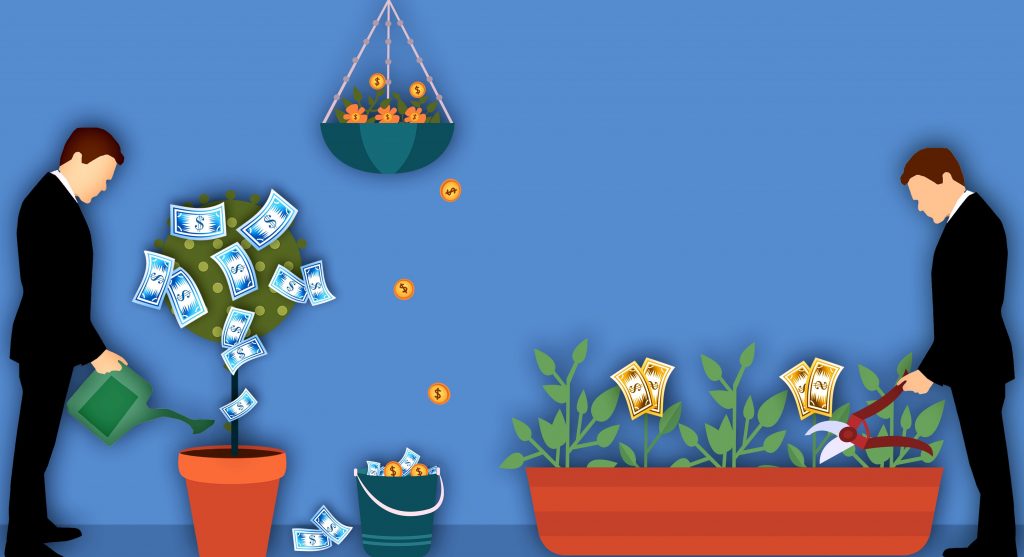 “Should I invest in my business or put the money in a savings account?”
“Should I invest in my business or put the money in a savings account?”
That was the question for 55-year-old Raafat Mahgoub, who owned a company that manufactured plastic bags.
The answer was a no-brainer.
“I saw interest rates climb from 9.25 percent at the start of 2016 to 11 percent a year later. My profit margins were about 10 percent,” he says. “Once I realized it was more profitable to put my money in the bank, I sold the business. Now I live off the returns.”
Mahgoub does not regret his decision despite interest rates declining from an all-time high of 18.75 percent between July 2017 and February 2018 to 15.75 percent this year. “If it drops below 10 percent,” he says. “I might feel as though I made the wrong choice.”
Even after the Central Bank of Egypt (CBE) left the overnight deposit rate at 15.75 percent during its July 2019 meeting, most manufacturers and many retailers say they still hope for a rate drop in August to help offset rising operating costs caused by higher taxes and escalating energy bills.
It’s widely acknowledged that eased rates would likely encourage entrepreneurs to take loans to invest in ongoing enterprises or start new businesses. Some economists, however, believe significant reductions in the short term could have adverse consequences, resulting in an outflow of dollars as international money investors look for higher-yield treasuries in other emerging economies.
Additionally, lower interest rates could hurt families attempting to supplement their income with higher yields on savings accounts. “That is the problem when debating interest rates,” says Alaa el Bahy, chairman of Fancy Foods, a producer of packaged snacks. “Changing them will have a significant impact that will result in advantages as well as disadvantages.”
According to Alyaa Mamdouh, chief economist at Beltone Financial, the primary motive for the Central Bank (CBE) when changing interest rates has always been fighting inflation. People tend to put more of their money in banks— instead of spending it—when interest rates are high. That dynamic dampens demand, prompting businesses to lower prices to retain sales. “We model our overnight rate forecasts on predictions of the inflation rate in the next few months,” says Mamdouh.
More recently, however, interest rates have been kept at historic highs to curb inflation-inducing side effects of ongoing fiscal reforms. “It helps discipline the market by lowering liquidity. It also keeps inflation at bay while the government tackles other issues, such as removing fuel subsidies,” says Khaled el Shafie, an economics and international trade professor at Cairo University.
Since the currency floatation in 2016, the CBE has been unusually busy adjusting the overnight interest rate. It increased from 9.25 percent in January 2016 to 18.75 percent by the start of 2018. Since, it has been dropping gradually, reaching 15.75 percent at press time. The primary justification for keeping interest rates well into double digits is to keep inflation between 6 percent and 12 percent, according to the CBE’s Monetary Policy Committee.
That target was achieved in three months after the pound lost nearly half its value in 2017 when inflation rates increased from just under 10 percent to more than 33 percent. In 2018, thanks to a stable foreign exchange rate between EGP 17.5 to the dollar and EGP 18, inflation rates cooled to less than 15 percent. So far in 2019, inflation has been hovering just over 14 percent, except in July when it declined to 9.4 percent, according to the CBE.
New dynamic?
That most recent decline in inflation rates to single digits for the first time since 2016 has some economists expecting the Bank to make another reduction by the last quarter of 2019. “If the inflation rate remains in single digits in the coming few months, the Central Bank would likely drop interest rates,” says Mamdouh. “I expect that could happen by August or September.”
Possibly justifying a rate cut in August is the appreciation of the pound, a factor indicating inflation is unlikely to spiral out of control. “The pound’s appreciation probably will mean less pressure on domestic finances [given that Egypt is a net importer],” says Hany Tawfik, former chairman of the Egyptian and Arab Private Equity Association. The government also says fuel is no longer subsidized and will now move with international prices. That negates a mid-year spike in inflation. “All that creates a better fiscal environment to accommodate a rise in inflation if interest rates are cut,” says Tawfik, who also predicts a rate cut this year.
Further underscoring the likelihood of CBE easing is that U.S. interest rates could also decrease. “The decision about how domestic [interest] rates will move is closely linked to the movement in America,” says Mamdouh. In June, U.S. Federal Reserve Chairman Jerome Powell signaled the Fed could soon cut interest rates. Powell was testifying before the House Financial Services Committee when he said ongoing trade wars could result in a global economic slowdown, which could make it necessary for the Fed to drop rates to maintain its economic growth trajectory. U.S. GDP grew by 2.85 percent in 2018, compared to 1.567 percent in 2016.
According to a report by Capital Economics published in July, Egypt’s interest rate could drop by 50 basis points from 15.75 percent without significantly increasing inflation. It also noted that if inflation continues in the neighborhood of 9.4 percent, interest rates by the end of the year should drop to 13.75 percent.
Thirst for cheaper funding
Even a minor downward adjustment would be welcome news for businesses. “Already, the slight drop in interest rates since the start of 2018 has helped some businesses revisit their expansion plans,” says Fathy el Tahawy, deputy head of the Household Equipment Division in the Cairo Chamber of Commerce. “We are already seeing many company owners withdraw money from banks to inject into their businesses.”
However, compared to historical trends, interest rates are still high. Between 2003 and 2016, rates remained under 10 percent. “That is the rate that all businesses have come to expect,” says Mohanad Adly, a member of the Federation of Egyptian Industries. The only exception was in 2008 in the aftermath of the global financial crisis and was squarely aimed at keeping foreign treasury investors in Egypt. Rates increased from 9 percent starting July 2008 to 11.5 percent in February 2009. They subsequently dropped to a 20-year low of 8.25 percent by October 2009. “We didn’t feel its impact on our financing because the increase was short-lived,” says Mahgoub. “Meanwhile, the low interest that followed was an immense help to me in fighting declining sales.”
A significant drop in the CBE’s overnight rate is vital in the short term insist industrialists, citing ongoing subsidy reductions and high-interest rates—unseen since 1994. “We lost our low-cost advantage since subsidies were removed starting 2015,” says Hamdy Abdel Aziz, head of Engineering Chambers in the Federation of Egyptian Industries. He points out that Egypt is now one of the more expensive emerging markets when it comes to manufacturing electronic devices. “Most companies in our sector have loans at an interest rate of 22.5 percent. We also pay VAT (14 percent) and income tax (22.5 percent), as well as contribute 0.25 percent to the Universal Healthcare System,” says Abdel Aziz. “That doesn’t make us competitive either locally or abroad.”
Mohamed Rateb, head of sales and marketing at Kapci Coatings, notes the most significant contributor to rising costs has been high interest rates. Rateb took out a loan in 2017 and another in 2018, both at the highest interest rates in more than 20 years. “We depend on local borrowing for 20 to 25 percent of our investment budget,” he says. “We had no option but to take these last two loans to cover our day-to-day expenses.”
To reduce dependence on expensive borrowing, Kapci Coatings Investment, a subsidiary, cut its budget for real estate investment. “We had to take that decision because the Kapci Coatings Investment business model depends on taking loans,” says Rateb. Meanwhile, the conglomerate’s chemicals and inks businesses have seen reductions in output. “We are reducing production to reduce our day-to-day costs. That translates to less dependence on borrowing,” he explains.
With a debt of EGP 70 million in loans at 18 percent annual interest, Bahy of Fancy Foods manages a tight budget. “We get charged a markup over the CBE overnight rate. That is the nature of the business,” he says. “As a result, that rate is too high for us now. That is unfortunate because the sector has, by nature, very tight-margins.” To improve his finances, Bahy is looking into applying for a loan from the International Finance Corporation (IFC) or another international source because their rates are significantly lower than those offered by Egyptian banks. “We can get 1 or 2 percent interest on such a loan,” he says. “The downside is that it must be repaid in dollars, and we don’t export that much. Ultimately, though, it may be our only option.”

Low interest dangers
While industry would benefit from an interest rate cut, some economists worry that a significant drop poses risks for the economy at large. The first reason to maintain current interest rates is to keep foreigners investing in locally-issued treasury bills. “Foreign investors put more than $18 billion in these instruments,” says Sahar el Damaty, former managing director and board member at Emirates NBD bank. “We can’t afford to see that money exit Egypt right now.”
Capital outflow is a realistic threat given that Turkey and Argentina have been increasing their rates to attract foreign investors as both nations face economic crises. Turkey has raised its interest rates from 7.5 percent in 2018 to 24 percent at press time. Argentina’s rates, meanwhile, doubled from about 30 percent in 2018 to 60 percent at press time. “Egypt may have better long term foreign direct investment prospects than either country,” says Shafie, the international trade professor. “However, when it comes to the short-term nature of treasury yields, return rates are more of a priority,”
The CBE, however, only needs to leave the rate unchanged to keep foreign treasury investments in Egypt, says Damaty. “There is no real need to increase it beyond 15.75 percent,” she stresses. One reason why Egyptian treasuries are attractive is that government finances are in better shape than in almost all other emerging markets. Egypt’s debt-to-GDP ratio topped 92.6 percent in 2018, and the government aims to reach 86 percent this year. In many other emerging markets, it is more than 100 percent, according to a June Bloomberg report. “Investors always seek to balance risk, represented by the debt-to-GDP ratio, and reward, embodied by treasury debt yields,” says Alan Sandeep, director of research at Naeem Holding.
Another reason why economists hope the CBE doesn’t reduce interest rates is the potential effect on household finances. According to Damaty, ongoing fiscal reforms have raised the cost of living to a point where many families need to supplement their income. Many savers regularly withdraw their savings interest. According to the CBE, household deposits nearly doubled since mid-2016, when interest rates started increasing, through March. They currently stand at more than EGP 2.1 trillion. “With people complaining about rising prices, I think it would be risky to lower rates,” observes Shafie, “even if it would benefit industry and, hence, the economy.”
Countering threats
Worried that the CBE is unlikely to significantly drop overnight interest rates in the short term, several industry groups propose a low-interest financing program exclusive to domestic manufacturers. “That would be a great way to move forward given how big the gap is between current rates and what we need to fix our businesses,” says Bahy of Fancy Foods.
Under such an initiative, manufacturers in Egypt would be charged 8 percent interest when taking a bank loan. Additionally, eligibility would no longer be determined by the size or legal status of the company. “I think all manufacturers would like to see such a program come to life,” says Abdel Aziz of the FEI Engineering Chambers.
If it does, it would not be the first time banks have set industry-specific rates. Abdel Aziz cites a 2016 initiative when banks quietly started making loans to factories at 7 percent interest. “What killed it was that the amount had to be at least EGP 40 million, and it had to be withdrawn in one go,” he says. “That amount was too high, even if it is taken in tranches.”
Despite interest rate concerns, most analysts give Egypt’s government high marks for reforms to improve the overall economic environment. “Looking at the big picture, fiscal policy reform has provided an excellent base for manufacturers over the past few years,” says Sandeep of Naeem Holding.
According to Abdel Aziz, the next step is for the government to build a structure on top of that base to sustain higher economic growth. The first piece would be monetary policy reform, according to Bahy. “Rising costs from fiscal reforms can be managed by making smart business decisions,” he says. “However, finding that your financing options are unfeasibly expensive is much harder to navigate without completely revisiting your model.”
Domestic manufacturers are concerned that delays in reforming monetary policy might push businesses out of Egypt to rival manufacturing centers in the region. One such destination is Morocco, where central bank overnight rates are 2.25 percent. The 2001 Agadir Free Trade Agreement makes accessing the Egyptian market easy and cheap for both Tunisian and Morrocan exporters. “Because funding costs are so much less in places like Morocco, it would even be feasible for large Egypt-based corporations to relocate there,” says Shafie. “Even if they are primarily catering to the Egyptian market.







